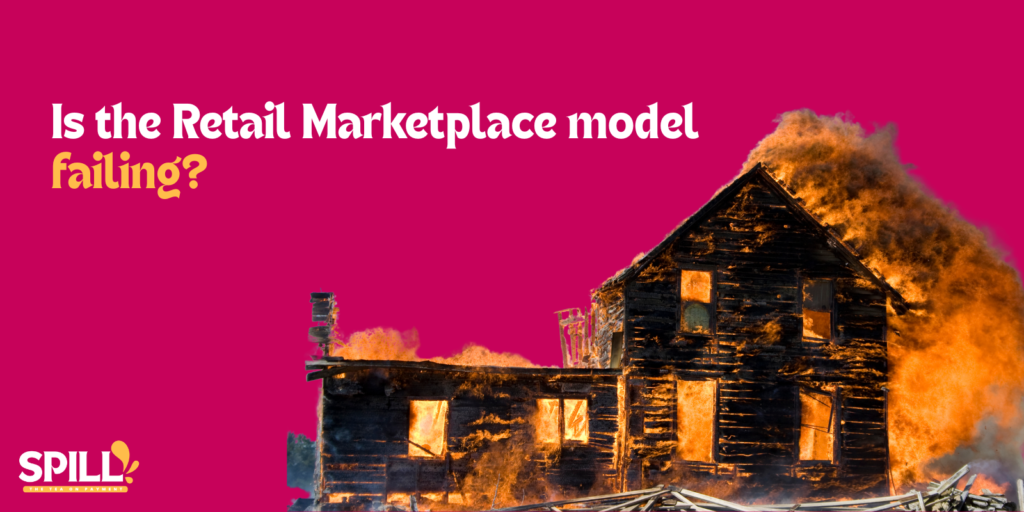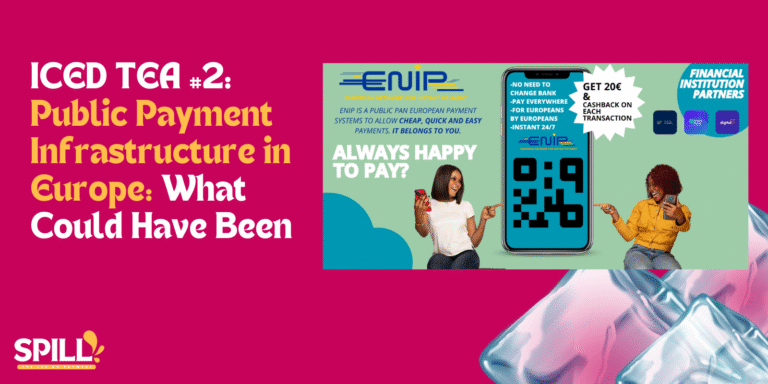The Rise and Disillusionment of the Retail Marketplace Model
Remember a couple of years ago, we were bombarded with blog posts, interviews, and case studies of customers in e-commerce that decided to become a retail marketplace. The retail marketplace model was dubbed the “future of e-commerce”. There wasn’t a single day we didn’t hear about the benefits of becoming a marketplace. It felt like a magical formula to save e-commerce from being stuck in the same code for 20 years. A breeze of fresh air and excitement was blowing.
Websites looked sexier than ever, but the experience within them stayed largely unchanged: browse, put in cart, pay, receive.
But the cool kids of e-commerce are living a disillusionment. I’ve witnessed a slow decline of the model, fewer crazy valuations, fewer PR announcements, and even some retailers like REWE in Germany abandoning their marketplace altogether. Also, market concentration is intensifying: in 2024, 48% of total worldwide marketplace sales by the top 100 were made by just three actors (source: Digital Commerce 360).
In Europe, the top 100 retail marketplaces account for 87,5% of all marketplace sales according to Cross Border Commerce Europe, a business facilitator in the marketplace/platform business.
Why the Retail Marketplace Model Is Struggling
Why such a situation? Marketplaces have become a financial bottomless pit to operate.
Ten years ago, when the model was less regulated, all retailers envied it: bigger catalogues, crazy upsell and cross-sell opportunities, and substantial savings on fixed costs like logistics and payments.
ManoMano, BackMarket, Vestiaire Collective, ASOS, or even traditional giants like Carrefour were there to sell the hype. The triptych of personalisation, diversification, and monetisation was appealing. It was also fueled by Mirakl, the French SaaS platform that invested heavily to make anyone a marketplace operator. Everyone wanted to disrupt traditional commerce or reinvent their identity. Traditional retailers, especially, were losing relevance as hypermarkets and malls lost their Saturday afternoon appeal.
Consumers wanted a personalised experience, tailored to their expectations. In just three clicks, they could access a wild catalogue of goods they never knew they needed—just for them.
Marketplace Platforms Still Have Untapped Potential
I still believe this model has incredible potential to rethink how we do e-commerce, especially now with the rise of AI, which can help platforms dramatically reduce operating costs.
- It boosts overall commerce efficiency, offering multiple product distribution touchpoints—not just traditional, high-barrier channels.
- It brings digitalisation to vendors who were previously left out. COVID proved that even small shops with limited digital literacy can join the e-commerce game.
- It reimagines customer experience through endless monetisation possibilities, by inviting third parties to enrich the journey.
What excites me most? When platforms offer more than just a marketplace of products, they create layered experiences. You and other participants co-create value, transforming a boring online store into something immersive.
This multiplies the creative potential of a website. Collaborations that traditional e-commerce would never consider, like exclusive segments, capsule drops, or pop-up stores, suddenly become brand storytelling tools.
The Hidden Cost of the Retail Marketplace Model
But behind the ecstatic words of SaaS providers and analysts, I can’t help but think this model is suffering. Why?
The cost of running a retail marketplace model has exploded: tax compliance, payments, logistics, customer service, you name it. Every SaaS vendor wanted their cut of the retail marketplace model. Many sold the illusion of quick profits and exponential revenue without disclosing that they barely reached break-even. VC money burned. Operators turned to external tools rather than investing in their unique value proposition. Millions went into marketplace projects that were short-lived trends.
A Reliance on Chinese Vendors Backfires
Another challenge: the extreme dependence on Chinese vendors. Operators scrambled to recruit them. Fueled by success in their domestic markets, Chinese sellers flooded into new regions. They brought affordable prices and massive inventories—but also poor customer service and complex payouts.
These vendors have become a “must” for launching marketplaces. But they also contribute to UX decline. Instead of improving experience design, operators maxed out their catalogues. The result? A sea of stuff nobody asked for. An overwhelming and directionless offer.
How many times have you scrolled endlessly through vendors and felt nothing really matched your intent? That’s the trap: quantity over quality.
A Shift Away from Global Commerce
Since the pandemic ended, consumer behaviour shifted. People no longer crave items from across the world. During lockdowns, overseas shopping offered escape. Now that borders have reopened, shoppers prefer to buy physically abroad.
Add rising tariffs and growing protectionism from large economies, and the retail marketplace model begins to wobble. It was built in a time when cross-border trade was a must for scale and relevance. But today’s world is fragmented, and trade wars complicate what used to be easy.
Some say the model is simply maturing. That it’s not for everyone. But I believed in something more open, before the current handful of platforms began defining what a marketplace “should” be.
When it emerged in Europe, the idea was to revive digital commerce: to build platforms as convergence points, not cold transactional spaces. Not a checkout tunnel where you dump things in a cart and leave.
Payments Are the Breaking Point
I used to say a couple of years ago: “The marketplace is an investment in the future.” I wasn’t that wrong. But if we zoom in on payments, because we spill the tea on payments, the retail marketplace model in Europe also suffers from specific regional problems that seriously damage its profitability:
- The explosion of interchange costs on cross-border transactions makes it more difficult to attract cardholders outside Europe. Vendors are less interested in getting a big invoice for payment fees. Operators are challenged by vendors on both the cost of service and its efficiency. They witness high costs for payment services (pay-in and pay-out) versus a lack of efficiency. Many follow the traditional playbook of merchant acquiring, which makes the merchants (here, the vendors) pay for the whole service. But do vendors agree to pay an extravagant ticket price just to reach customers they could access through other channels?
- The PSD2 obligation to segregate and escrow funds adds a heavy operational layer, even for platforms that don’t transact high volumes through their marketplaces. It complicates the setup with the need for Payment Institutions, KYC obligations, even for merchants that only occasionally transact. It’s a binary approach that damages the model’s profitability. Regulation was created with big platforms in mind, but without a gradual framework to ensure the model was sustainable. The result? Some offshore platforms scale their business outside Europe first, then invest heavily in the European market later. That doesn’t help local actors, and few survive.
- Acquirers and schemes remain uncertain about the model. Acquirers now prefer to consider marketplaces as merchants of record, which goes against the original principle of marketplaces. Operators don’t understand why they should suddenly assume the risks of others because their payment service providers can’t underwrite and map credit risk across sellers. But scheme rules and technical capabilities restrict the model’s growth—we monitor transactions poorly and ask far too much for relatively small volumes.
How to Inject New Life into the Retail Marketplace Model
So how could we put a little bit of va va voom into this model that still remains ambitious?
- Changing our vision of marketplaces from a compliance point of view. Consumer protection is important but should be balanced with the merchant’s capability to execute and the size of business involved. Consumers now prefer using cheap platforms from China over a European retail platform—and they’re still not as protected.
- Promoting easier and safer alternatives to card payments to alleviate the chargeback sword of Damocles hanging over merchants’ heads. A safer alternative could help merchants avoid being wiped out by chargebacks.
- Creating clearer and harmonized rules when it comes to processing a marketplace transaction via international card schemes. Acquirers today are caught in the middle. I still believe they do not understand how this model works and only onboard mature models because schemes did not harmonize. Today, it is still too obscure to build a standardized product that allows marketplace operators to process transactions seamlessly.
Schemes do not want to deal with marketplaces and instead support extreme concentration to mitigate their risk. But that is not a winning strategy. Once a better solution appears for marketplaces, they’ll abandon the current setup.
China still serves as a cautionary tale; the most developed market for platforms is now cardless, schemeless. Platforms there built their mechanisms to ensure efficient transaction monitoring. I wouldn’t be surprised to see Ant Financial begin selling its payment solution, ANTOM, to European marketplaces.










